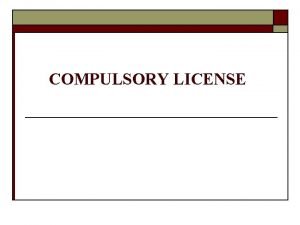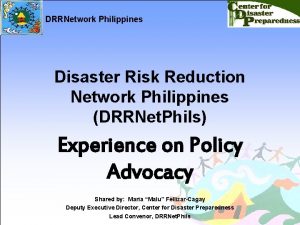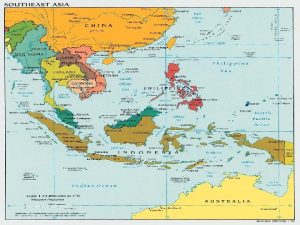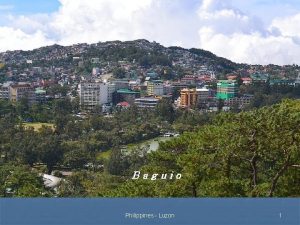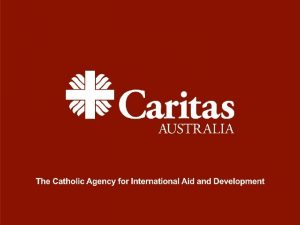Compulsory Case Study 2 Philippines The Philippines is



























- Slides: 27

Compulsory Case Study 2 - Philippines • The Philippines is situated South East of mainland Asia, North of Indonesia. • The country is made up of more than 7000 islands. Many are very small and difficult to reach. • Manila is the capital city and in 2007 there were 91 million people in the Philippines. • And the country was formed in 1946. • The islands are at latitudes 5– 20°N of the equator.


• It is one of the most disaster-prone countries in the world. • The Philippines is a hazard hotspot for a number of different reasons. • It is situated on a major plate boundary. • Its north and east coast faces the pacific (seismic and world’s greatest tsunami risk. ) • A tropical monsoon climate is experienced there, and it is subject to heavy rain. • The country lies in SE Asia’s typhoon belt. • So it gets typhoons, storms, earthquakes, floods, volcanic eruptions and droughts (and more!).


• The Philippines is a lower middle income country and it is developing fast. • It has a rapidly increasing young population. • Average population densities across the country are high with 240 people per sq km. • In Manila there are up to 2000 people per sq km. • Many people are very poor and are residents near the coast.

Tectonics of the Philippines • The dense oceanic Philippines plate is being subducted beneath Eurasian plate at a destructive plate boundary. • Creating the Manila Ocean trench. • Both volcanoes and earthquakes are occurring. • Read p 25 Oxford


Geophysical hazards: Volcanic eruptions 1900 -2012 • 25 events • 2, 996 killed • 1, 734, 907 affected • Losses of US$ 232 million EM-DAT (2012)

Mount Pinatubo eruption 1991 • P 24 -25 Oxford • http: //pubs. usgs. gov/fs/1997/fs 113 -97/

Earthquakes 1900 -2012 • Events 24 • Killed 9, 693 • Affected 2, 543, 574 • US$ 528. 5 million (EM-DAT) • One earthquake in 2006 killed 15, injured 100 and damaged 800 buildings. It generated a local tsunami 3 m high and triggered landslides of material from the Parker volcano into the Maughan Lake making a flood which washed away houses




Tsunamis • 1900 -2012 1 event 1976 32 killed (EM – DAT) • Small locally generated waves could be problematic • The Pacific Ocean has the largest potential for tsunamis in the world

Hydro-meteorological hazards: Typhoons 1900 -2012 • 267 events • 38, 238 killed • 114, 006, 747 affected • Economic losses US$ 7 billion (EM-DAT) • Some years 10 typhoons occur in a season • Approx 6 -7 major storms per annum. • It is the belt of SE Asian typhoons


Storms Unspecified type of storm 1900 -2012 • 26 events • 812 killed • 3, 110, 501 affected • Economic losses US$112 million Local storm 1900 -2012 • 4 events • 9 killed • 24, 704 affected • Economic losses US$ 5000


Floods Unspecified type of flood 1900 -2012 • 33 events • 1, 440 killed • 7, 680, 373 affected • Economic losses US$ 352 million Flash flood 1990 -2012 • 38 events • 1, 147 killed • 5, 700, 690 affected • Economic losses US$1 billion

General Flood 1900 -2012 • 45 events • 539 killed • 6, 028, 676 affected • Economic losses US$116 million Storm surge/coastal flood 1900 -2012 • 11 events • 149 killed • 125, 931 affected • Economic losses US$ 2, 6 million


Land slides Mass movement dry 1900 -2012 Landslide • 2 events • 311 killed Rockfall • 1 event • 50 killed

Mass movement 1900 -2012 Avalanche • 1 event • 6 killed • 1, 200 affected Landslide • 28 events • 2, 148 killed • 313, 508 affected • Economic losses US $33. 3 million Subsidence • 1 event • 287 killed • 2, 838 affected EM-DAT

The Guinsaugon landslide 2006 • P 26 Oxford

Droughts 1900 -2012 • 8 events • Killed 8 • Affected 6, 553, 207 • Damage US$ 64. 5 million EM-DAT

Wild fire 1900 -2012 • 1 event • 2 killed • 300 affected EM-DAT

Government response • Several organisations have been established to forecast, warn, risk assess, disaster train and educate: • National disaster co-ordinating council • Philippine Atmospheric, Geophysical and astronomical services • Philippine Institute of Vulcanology and Seimology (PHIVOLCS) • Land use planning • Building regulations • Structural programme of defences
 Four compulsory subjects
Four compulsory subjects Right of children to free and compulsory education
Right of children to free and compulsory education Slidetodoc.com
Slidetodoc.com Industries requiring compulsory licensing *
Industries requiring compulsory licensing * How many rakats in each prayer
How many rakats in each prayer Tayammum
Tayammum Cdtcc
Cdtcc What factors affect voter behavior
What factors affect voter behavior Judge muth east stroudsburg pa
Judge muth east stroudsburg pa Features of rte
Features of rte Best case worst case average case
Best case worst case average case Hershey's erp failure
Hershey's erp failure Hình ảnh bộ gõ cơ thể búng tay
Hình ảnh bộ gõ cơ thể búng tay Lp html
Lp html Bổ thể
Bổ thể Tỉ lệ cơ thể trẻ em
Tỉ lệ cơ thể trẻ em Gấu đi như thế nào
Gấu đi như thế nào Tư thế worm breton là gì
Tư thế worm breton là gì Hát lên người ơi alleluia
Hát lên người ơi alleluia Môn thể thao bắt đầu bằng từ đua
Môn thể thao bắt đầu bằng từ đua Thế nào là hệ số cao nhất
Thế nào là hệ số cao nhất Các châu lục và đại dương trên thế giới
Các châu lục và đại dương trên thế giới Công thức tính độ biến thiên đông lượng
Công thức tính độ biến thiên đông lượng Trời xanh đây là của chúng ta thể thơ
Trời xanh đây là của chúng ta thể thơ Mật thư tọa độ 5x5
Mật thư tọa độ 5x5 101012 bằng
101012 bằng Phản ứng thế ankan
Phản ứng thế ankan Các châu lục và đại dương trên thế giới
Các châu lục và đại dương trên thế giới




























